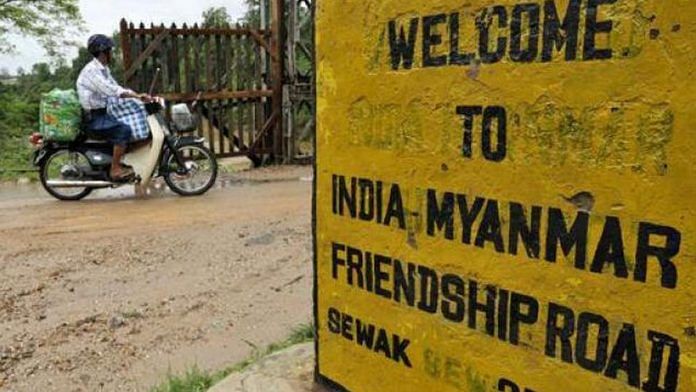India believes it’s the right time for free movement because it has a good relationship with Myanmar, and this would buttress the Modi govt’s ‘Act East’ policy.
New Delhi: India and Myanmar have quietly activated a ‘free movement regime’ (FMR) for people residing in villages near their 1,643 km-long border.
The agreement had figured in on-again-off-again talks for years. In January this year, the Indian cabinet approved it, but Myanmar forced a deferment in March citing its own limitations. Last year, India had deferred it, fearing that it would aid the influx of persecuted Rohingyas into India.
But in August this year, New Delhi and Naypyitaw decided to implement the FMR along a 32-kilometre band — 16 km on either side of the border, which passes through harsh terrain, as also through plain land and water bodies.
Also read: Between a ‘Hindu India’ and ‘Buddhist Myanmar’, a secular Bangladesh is under pressure
A deep impetus for the current move is trade, and the development dividend that may offer with a connect to the planned Asian Highway 1, which extends from Thailand, through Myanmar to Kunming in China and also to Laos and Cambodia. That is one of the stated objectives of New Delhi’s ‘Act East’ policy that is reaching out to South-East Asian nations, a senior official involved in India’s eastern strategy explained to ThePrint.
“The idea is to be able to travel from Kolkata to Yangon or Kunming through Bangladesh and the Northeast without impediment,” he said. India and Bangladesh have regular train services.
Why now?
There were three reasons the Indian government decided that the FMR could be implemented now — diplomatic, political and social.
First, it determined that its relationship with the Myanmarese government is the best in recent years. Also, implementing the FMR would aid the Modi administration’s re-statement of New Delhi’s ‘Act East’ policy.
Second, it would help address the political support that militants of many groups derive from their ethnic affinities with tribes on both sides of the border.
Third, there are genuine cultural and economic ties that villagers on both sides share.
Implementation and concerns
The current experiment with the FMR was first prompted by a study commissioned last year by minister for home affairs Rajnath Singh. The study recommended routes for people to transit.
It said that the four state governments involved — Arunachal Pradesh, Nagaland, Manipur and Mizoram — should make identity papers available to deserving villagers in their territory who could prove their domicile within 16 km of the border.
Myanmar is expected to do the same within its territory. But that is where the biggest security concern is for India.
India has five times as many security personnel — mostly of the Army and the Assam Rifles — than Myanmar has on its side of the border. Myanmarese forces are also committed to operations against militants who are in areas that are not adjacent to the border with India.
India’s experience with FMR
An FMR has been accepted as one way of dealing with disputes on boundaries by border management experts. The best known example is, of course, the European Union, which allows free movement of the citizens of European countries within the borders of the continent.
Even countries that have “hard” borders have allowed exchanges. India has done so with Pakistan in Kashmir, where it has a weekly bus service going through Uri and Poonch-Rawalakot despite intermittent exchanges of fire. India has also done so with China in Sikkim, where there is seasonal border trade through the Nathu La since 2006.
Also read: Over a year after Doklam, India and China to resume Army exercise this December
On its longest international boundary — with Bangladesh — it permits trade and transit through the Petrapole-Benapole border, as well as train services between Kolkata and Dhaka. It is now considering trade and transit through the Sonamura point in Tripura.
In large measure, India’s uneven and undefined borders are a colonial legacy.
The India-Myanmar border has been mostly calm, despite drug-running mafiosi, insurgents and sudden spurts in refugee movement threatening to disturb the peace.



